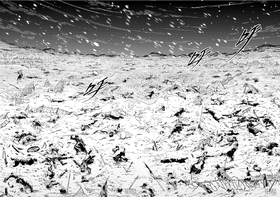Kazimierz
| Faction | Overview | Branches | Interactions | Gallery | Trivia |
Kazimierz, formally known as the United Knightly Territory of Kazimierz (Zjednoczone Terytorium Rycerskie Kazimierza)[1] or the Kazimierz Alliance (Przymierze Kazimierza) for short,[2] is a Terran country bordering Columbia, Leithanien, Sami, Ursus, and Victoria that occupies much of the northern grasslands. It is a confederation of feudal chivalric orders with the Grand Knight serving as the head of state. The majority of Kazimierzians are of the Kuranta race, which is reflected on its national emblem resembling a knight piece.
Dubbed the "Land of the Knights and Commerce," Kazimierz has been famous for both its generational knightly tradition and the newly risen merchant class. The nation began as a confederation of fiefdoms serving the Elder house of the Pegasi until the usurp of the royal house by the Nightzmoras and the knights. Entering the modern era, a series of commercial incidents nourished its capitalists that modernized the nation, but the process came into conflict with the traditional knights who despised their greed and corruption. The economic imbalance also results in inequality in development between its rich mega-cities and its remote, sedentary villages.
Although the Kazimierzian society has been much open as it modernizes, it still retains its old feudal traditions like chattel slavery and hierarchical structure. In the Infected's case, they are outwardly treated better than many other places in Terra; however, they are being discriminated against behind the scenes such as gladiatorial fights between Infected competitive knights in both open and underground tournaments and living in underground ghettos.
The Kazimierzian language is similar to Polish in our world. But somehow, both have distinct grammars and accents even though both are mutually intelligible enough with each other.
History
Pegasian dynasty
At the dawn of civilizations when nation-states slowly existed, there arose the Pegasi, a royal house of Kuranta Elders, who refused to be subjugated by other races. They formed the earliest Knight Order with their loyalists and began a series of conquests on the Kazimierzian grassland, a fertile region that became the battleground of a tug-of-war between other factions vying over its control. The Pegasi succeeded in expelling other competitors, built castles and settlements in the region, and distributed fiefs to other knights as a reward for their services.[3]
As Kazimierz gradually expanded, the newly-established knights suffered from internal disputes and misdirection. The Pegasi decided to reform the knighthood system by splitting the old and new knights, setting up a political hierarchy that enacted the rights of every knight, servant, and civilian, and allow other races to join their ranks. Seeing that their monopoly over other knights slowly diminished, the Pegasian house then declared themselves as the absolute monarch of all knights, eventually laying the foundation of the Pegasian Kingdom.[3]
At the dawn of the common era in 12th Terran year, the Pegasi encountered the invading hordes of the Nightzmoran Khaganate of Kharanduu Khan after he annihilated the Empire of Hippogryph. Soon enough, the Pegasian regime was unprepared for the Nightzmoran hordes, eventually falling and being surrounded by the Nightzmoras' psychic Originium Arts. The Pegasi were forced to admit surrender to the Khaganate following a humiliating defeat, and they were fortunately preserved through peace negotiation.[4]
On the other hand, not every Kazimierzian accepted such a treaty of humiliation that tarnished their glorious chivalry. The knight orders refused the Pegasi's negotiations and reorganized their resistance against the Nightzmoras until the hordes' departure. A year later on the 13th Terran year, much of Kazimierzian territories were de facto independent fiefdoms freed from the Pegasi' control. The shift of power from the royal house allowed the knight orders to form a united alliance with the servants and the commoners, and they launched a rebellion that usurped the Pegasian regime. With the end of monarchy came the rise of Kazimierz's unique noble democracy as the United Knightly Territory; the foundation of the Adeptus Sprawiedliwi and the National Council by the knight-nobles marked the end of strives between fiefs during the provisional era, even though its conflict still lingers on.[5]
Rise of the merchant class
The era of conflict with the Nightzmoras forced the knight-nobles to hand in their properties under the care of the retinues. In the process, the retinues slowly gained control over Kazimierz's economy which had been long neglected by the knights. By the time of the foundation of the noble democracy, the retinues became a dominant political entity that the knights could not underestimate.[5]
For the remaining centuries, the knights and the retinues remained a frail balance of power; the knights controlled much of the military while the retinues focused on economic activities. This status quo, however, was broken by the time of the industrial revolution that ushered in the Crystallization Age. Around 120 years ago in Terran year 977, the National Council held a nation-wide auction event to sell the land property of a deceased heirless knight-noble, a castle on his nomadic platform. The winner of the bidding was not the nobles but rather the noble's retainer who accumulated a skyrocketing amount of money, and after several legal progresses, the retainer became a nouveau riche overnight.[6] The nation-wide auction inspired others to follow, eventually leaving the old knight-nobles virtually penniless with the retainers becoming almost indistinguishable with merchants who controlled both the economy and the military.
The rise of the merchant class prompted the traditional knights to renegotiate the balance of power following the foundation of the Kazimierz General Chamber of Commerce; they agreed to relinquish parts of their political power and willingly sought cooperation in decision-making. But as time passes, the K.G.C.C. became the de facto ruling body through economic activities that control the national revenue and corporations in nomadic cities, leaving the Adeptus to focus more on maintaining social order via military leadership.[5]
Ursus-Kazimierz Wars
The Ursus-Kazimierz Wars are a series of ten campaigns of territorial expansion between Kazimierz and the Empire of Ursus. Kazimierz had a long history of conflict with Ursus since the Hippogryph dynasty through various large-scale skirmishes.[3] Following the rise of the Ursine regime, Ursine expansionism slowly stretched onto Kazimierzian soil under Emperor Alexei Igorevich's "Eastern March" policy. In the first few years, Kazimierzian knights, armed with well-equipped weapons, easily defeated the Ursi troops. But the latter’s military and political reformations allowed the Ursi to gain the upper hand, resulting in a stalemate for the remaining centuries.[7]
Between the year 1019 and 1062, the Ursi initiated the tenth campaign, successfully defeated the Kazimierizans, and fully occupied much of Kazmierzian territories. To pacify the masses, the Kazimierzian government propagated that Kazimierz gained more benefits from the war through social stability that did not affect the economy, hence declaring them the "real victor."[8] The merchant class gladly accepted the propaganda as it further promoted their mercantilism, but the campaign knights held bitterness over the Ursine occupation.
A decade later in 1072, Ursus' military capability greatly deteriorated after Emperor Vladimir Ivanovich getting ill as well as the failed Bloodpeak Campaign against Higashi. In the midst of the war, the Kazimierzian campaign knights grasped the opportunity to recapture their lost territories as Ursine defense on the west grew weak.[9] The campaign knights underestimated the Ursi's defense line, but under the leadership of the war hero Kirill Nearl and the House of Nearls, they not only rescued the surviving knights, but also continued their eastern march that recaptured much of the lost Kazimierizian cities and annihilated around 3,000 Ursine soldiers occupying the region.[10] The battle, later known as the "Daybreak over the Golden Prairie," was the turning point of the Ursus-Kazimierz Wars that ensured Kazimierz's border security from foreign invaders.
Present days
By present day, the struggle between the traditionalist aristocrats and the modernist merchant class persists on. The knight-nobles and the campaign knights see the capitalists and their competitive knights as weak imitations and even a blasphemy of their proud tradition, while the corporate leaders see the aristocrats as backward and obstinate, oblivious to the relentless march of progress in the modern era.[11] Such is the clash between tradition and modernity, between knightly honor and materialism fostered by the prosperity of modern age; the two factions sabotage each other either through manipulation of national laws or by underground means like hiring the Armorless Union. But amidst this conflict, there are still some moderates who seek compromises to transcend short-sighted differences.
The campaign knights continue to be an essential force that maintains Kazimierz's security. On the other hand, there is a rising voice among them who seek to unleash Kazimierz's military capability and revitalize the long-lost chivalry through active territorial expansion. To this day, Kazimierz still conducts border skirmishes with Leithanien especially since the Witch King era, and the nation also begins to exert political influence onto Kjerag since the end of the theocracy's isolationism despite its political neutrality.
Notable people
| Expatriate | |||
|---|---|---|---|
| Migrant | |||
- Jostk
- Demian: The current Vice-President of the Knights' Association and a close acquaintance of Ioleta Russell the Grand Knight.[9]
- Duke: The former Associate Justice of the National Council who was arrested during the 24th Major season for being suspected of numerous crimes.[12]
Enemies
| Normal | |
|---|---|
| Elite | |
| Boss |
Places
Settlements
- Kawalerielki
- Dewville
- Dzwonek
- Ognisko: Once known as the "City of Saplings and Artisans," it is surrounded by numerous slums, one of which is where Mob was born into.
- Twierdza: A rural village close to Dzwonek that was once owned by a Knight Noble named Marek, who decided to hypothecate it to Gale Industries seven years ago, only for him to turn arround and sell it to the villagers, who bought the farmlands for ten years worth of tax incomes. After his passing due to illness, Gale Industries would put the village on their demolition and relocation plans, revoking their farmlands.[13]
- Strumykowo: A village close to Dzwonek which already sold its lands to the megacorporations.[14]
References
|


